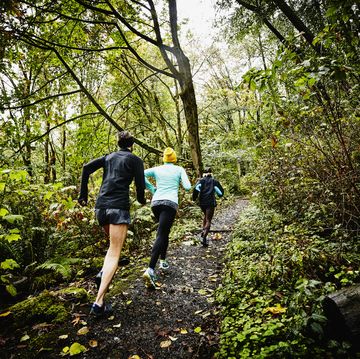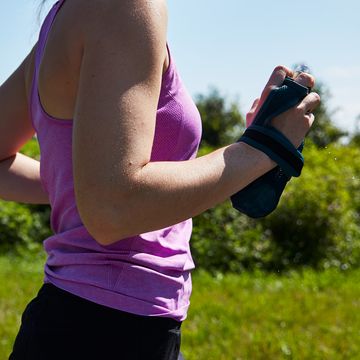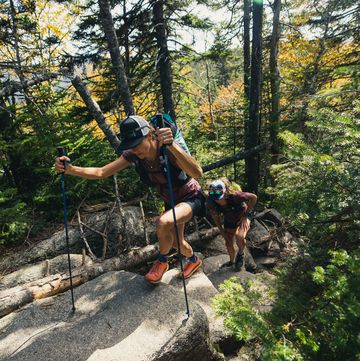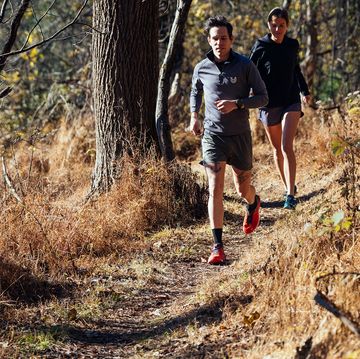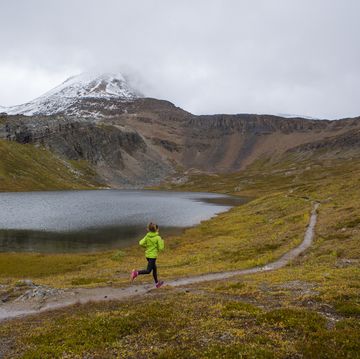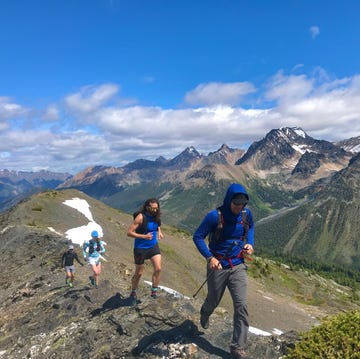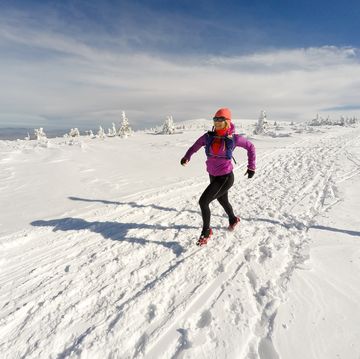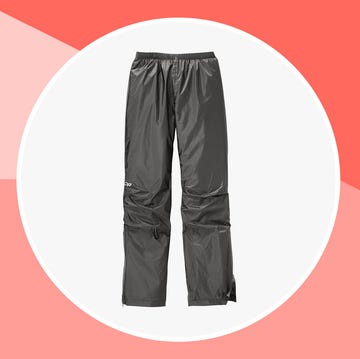I was already in love with the Dipsea in 2003. Perhaps that's why I felt I was going to heave. I stood in downtown Mill Valley, California, where the race has begun since 1905. Seventy-five-year-olds chatted with their granddaughters--all in race bibs--as birdsong filled the misty air. I tried not to panic. It was my fifth shot at the viciously good-looking course. My test would start with a mad, elbows-out dash up 676 stairs. Then I'd grind over muddy, rooty hills named Dynamite and Cardiac. Between lactic bouts, I'd gape at lush ferns, towering redwoods, and expansive views of the Pacific. In front of me? The oldest and youngest racers, who'd start first and on whose backs I'd place targets. Behind me were speedsters and rookies, coming fast. All 1,500 of us barreling toward the finish in orchestrated chaos. No other race has the same mix of beauty and brawn, the same history and curiosity. And no other race has black shirts that can make people weep with envy.
The year before, I'd shocked myself by placing 53rd, close to earning one of those fabled, numbered T-shirts given to the top 35. Now I wanted to join the club.
The Dipsea, born as a bet between two men in a bar in 1904, will celebrate its 100th running on June 13. (The race took a break during the Depression and WWII.) It's only a few years younger than the Boston Marathon, and while Boston has live TV coverage, police escorts, and six-figure prize money, the Dipsea remains homegrown with charming quirks.
While the course is notoriously brutal, getting in may be even harder. To snag one of the 1,500 spots, you need to be persistent, distinctive, and lucky. The race committee, a somewhat mysterious entity, reads pleas and unapologetically takes bribes (which go to trail maintenance). Thanks to its handicapped starts, a 9-year-old girl and 70-year-old man can win--and have. Racers can improvise at times, which favors wily veterans who thrash onto legal shortcuts.
I first heard about the race in my 20s while hiking the Dipsea Trail's steep descents and quad-searing climbs. After reaching a spot where wheat-colored grasslands frame the distant Pacific, I noticed blue and white ribbons on trees. Another hiker said they marked the course of a race held that day. My eyes widened. A race on this rooty, treacherous, gorgeous singletrack? I was smitten.
It took me three years to get some action. I sent letters to the committee, sharing my love for the trail, my race times, and some pathetic pleas. Finally, in 1998, a race number appeared in my mailbox. I felt like I'd received a love letter.
Yes, I'm a bit obsessed. I worry someone will plan a wedding on the second Sunday in June. I moved to Mill Valley for short stints twice. I've paid the entry fee each year since 1998, even if I was injured.
When I can race it, I scramble--or hobble--toward the beach as if my life depends on it. Finishing high enough guarantees a spot in the next race, which, to me, is worth aggravating an injury. Hurt or not, the Dipsea is always hard.
It certainly was on that June day in 2003. After a steep climb to the Panoramic Highway near mile six, I was covered in dirt and bloody from falling. I had no clue what place I was in, but I furiously kicked it in as if I was 36th. I placed 74th. Let's say I was happy but unsatisfied.
I've been dreaming of another shot at a shirt ever since. This year, it's out of reach since I'm rehabbing a sore hamstring. But in two years, I'll celebrate my 40th birthday, and the 60-second headstart that comes with it. Assuming they let me in.
GETTING IN
The Dipsea field is capped at 1,500 to help preserve the trail and minimize bottlenecks. Organizers usually receive 2,500 applications. Here are six ways to acquire a coveted race number.
1) Finish in the top 750 in the previous year's race. Finishers in the top 450 earn a spot in the Invitational section, which starts first. (Organizers also reserve the right to grant Invitational status based on past performances.) About 600 runners return from this group each year.
2) Mail in the application posted on dipsea.org in mid-March to nab one of the 500 first-come, first-served spots. No FedEx, UPS, or hand delivery is allowed. This intentionally favors locals.
3) Win one of 100 entries in a silent auction. Money paid over the $60 entry fee goes to the race foundation.
4) Win one of 300 spots chosen at random and from pleas--see number 6.
5) Win one of two bibs auctioned at the annual Dipsea Race Dinner, held two days before the race. Bids start at $500.
6) Send an original plea, significant bribe, or convincing sob story ("true or not," says committee member Merv Regan), and hope it gets some attention.
GETTING TIMED
The Dipsea has always had a handicapping system, but from 1905 to 1965, head starts were based on perceived ability. Now starting groups are divided by age and gender into 26 waves, spaced one minute apart, in both the Invitational and Runner sections (700 and 800 runners, respectively). The oldest and youngest competitors start first. The first wave in the Runner section starts two minutes after the final Invitational wave. First one to the beach wins. This set-up makes it impossible for someone in the Runner section to win. For more on head starts, go to dipsea.org/handicap.html.
TOP HONORS
Running's most coveted shirt has humble beginnings. In 1974, an official loses track of runners' order at the finish; runners have to tell organizers their place. In 1975, to avoid confusion, blue shirts with red numbers on the back are given to the top 25 in the chute. In 1976 and 1977, shirts are yellow with blue numbers. In 1978, the awarding of shirts becomes a postrace ceremony; shirts are worn backward and runners line up in order. That year, the top 35 get black shirts with the race logo and year on the front and their place on the back in gold. The lettering changed to silver in 1979.
CRAZY BEAUTIFUL
A Runner's-Eye View of the Dipsea Course
The Start: The gun fires in Mill Valley, at the flagpole across from The Depot Bookstore & Cafe, an old train station.
0.4 miles: 676 Dipsea steps, in three flights. The first is 313 steps, the second is 222, and the third is 141 (or 142, with the curb). You climb 500 feet in 0.7 miles.
TIP: Run on the dirt alongside the first flight of stairs if they're crowded.
1.2 miles: Cross Panoramic Highway, turn right and begin the first descent through Windy Gap/Hauke Hollow before 0.44 miles of gradual downhill on paved Muir Woods Road.
TIP: Slightly downhill and on open road; this is a good place to pass.
1.9 miles: The mailboxes at the top of private Camino del Canyon Road mark the beginning of a steep trail descent. About 100 yards later, the trail splits. To the left is a steep, narrow route nicknamed "Suicide," and to the right, a gradual descent on the Ranger's Trail.
TIP: Veterans take Suicide. It's faster, but footing is tricky. (see map)
2.0 miles: Enter Muir Woods National Monument, an area with redwoods upwards of 250 feet tall and 800 years old (the oldest is at least 1,200). Cross Redwood Creek on a wooden plank to begin climbing "Dynamite," a half-mile-long ascent lined with ferns and poison oak.
2.5 miles: "The Hogsback," a 1.06-mile-long stretch of grassland where the Dipsea Trail and fire road intersect several times. The Pacific Ocean is in full view for the first time on the course.
TIP: If the singletrack is crowded, consider taking the fire road for short sections. It's a hair longer but much wider, making it easier to pass.
3.26 miles: "Halfway Rock," a large rock on the left of the trail. It lies before halfway, but since much of the route has been uphill, it marks about half the total run time.
3.5 miles: "Deer Park," or "The Rainforest," where the trail dips back into Muir Woods and passes a few giant downed trees with exposed roots.
4.0 miles: "Cardiac" hill. After the stairs, this is the steepest section. Rooty terrain climbs one-fifth of a mile.
4.3 miles: Highpoint at 1,360 feet; first official water station.
5.0 miles: "The Swoop," open only on race day, is a steep, narrow descent through a grassy ravine. To the right is the "Gail Scott Trail," named after the runner who took the longer route in 1987, costing her the win.
TIP: The Swoop may be faster, but the Gail Scott Trail is much more runable and easier to pass on.
5.6 miles: "Steep Ravine," 0.22 miles of steeply descending stairs and slick mud amid ferns and redwoods.
TIP: Skip as many stairs as you can (Russ Kiernan used to leap four at a time). He says, "I run that section sideways to get a good foot plant on the steep ones."
6.2 miles: "Insult Hill," the final short climb, with water station number two at the top.
6.3 miles: A left stays on the Dipsea Trail and heads into "The Moors;" a right goes to Panoramic Highway. The former is wider and has one more hill. The latter jumps between the highway and the trail before a creek crossing, dubbed "Kiernan's Crossing" since 1979 when he left the trail for what he thought was a shortcut, likely costing him the win.
TIP: The Moors is a simpler and more scenic route (it boasts a view of the beach below), but the highway option is faster. However, the latter requires knowing where to reenter the trail twice; not knowing could be disastrous.
7.1 miles: "The Stile," a shin-high fence that's marked with caution tape or balloons on race day, followed by the drop onto Highway 1.
7.2 miles: 150-yard downhill sprint on Highway 1, then a left onto a park maintenance road (open only on race day) for a 200-yard descent, then one final turn before hitting the 490-foot finishing chute.
7.4 miles: Finish at the Stinson Beach parking lot's south end.
LEGENDS OF THE TRAIL
Russ Kiernan, 72, has 28 black shirts, more than any competitor. He's won three times (in 1998 at age 60; 2002 at 64; and 2005 at 67), has placed second seven times, and has 27 top-10 finishes, a feat unmatched in Dipsea history. Kiernan celebrated his 72nd birthday by running the course and hitchhiking back to his home in Mill Valley.
Emma Reiman, (1899-1990), dominated the so-called women's "hikes" (to avoid a ban from the Amateur Athletic Union) from 1919 to 1922, winning twice and placing second twice. The hikes were canceled the next year, and another woman didn't race until 1950, though unofficially. Reiman's 1922 time of 1:12:06 was the women's record until 1969.
Sal Vasquez, 70, has won a record seven times, the impetus for officials to penalize past winners. The now-revised "Sal Vasquez Rule" stated that a runner lost one minute for every win in the five previous years. Vasquez hasn't raced since 1997. He's rumored to be returning this year, with a 21-minute handicap.
Megan McGowan, 28, was second as an 8-year-old in 1990. In 1991, she became the race's youngest winner. In 1992, despite losing four handicap minutes from the year before (one for winning, one due to committee changes, and two for turning 10), McGowan defended her title and had the fastest women's time that day. She last ran in 1993, placing fourth.
Jack Kirk, (1906-2007), the "Dipsea Demon," ran 67 years in a row, including wins in 1951 and 1967. A competitor in Kirk's first race in 1930 said: "The way Kirk runs down those hills, he must be a demon." Once, he was arrested for shooting at trespassers; he trained by running circles in a jail cell. Friends bailed him out race morning and drove him to the start. Kirk finished his last Dipsea at age 95.
RUNNING THE NUMBERS
70 Age of oldest winner, Joe King, who clocked 1:09:19 in 1996 with a 21-minute head start
3,500 Most applicants; a tie between the 100th anniversary (2005) and 100th running
446 Highest finish by a competitor in the Runner section (1978, 934 finishers)
2 Length of closest winning margin, in seconds, set by Leslie McGregor in 1948
49 Longest current streak, in years. Phillip Smith has run every year since 1961.
9 Age of youngest winner, Megan McGowan, who won in 1991
44:49 Best men's time, set by Ron Elijah in 1974. The course is now a bit longer.
55:47 Women's course record, set by Peggy Smyth at age 36 in 1988
676 Number of steps in the first mile. Repairs in 1993 upped it from 671.
7 Most wins by one person, Sal Vasquez, who won in 1982-85, '90, '94, and '97
1,638 Largest recorded field, in 1976, though more than 2,000 people ran
A LONG-RUNNING SAGA
Dipsea's Evolution From Intimate Affair to Cult Classic
1854 The Dipsea Trail appears on the first county trail map. The name may have come from the appearance of the trail dipping into the sea.
1905 Eighty-four men race (inaugural program, above). One paper calls it "the greatest cross-country run that was ever held in this or any other country." Runners can take any route they wish.
1918 307 women compete in the first "Dipsea Hike." The hike is canceled in 1923 under pressure from church groups and physicians. (1920 hike, below)
1932-33 Two-year break during the Depression, after sponsor The Olympic Club pulls out. Sponsorship from San Fran's Sunrise Breakfast Club resurrects the race.
1942-45 Race is canceled for four years during World War II.
1950 Nancy Dreyer becomes the first woman to run with the men, though unofficially.
1971 The AAU opens longdistance running to women. Frances Conley is the first official female finisher.
1974 Actor Bruce Dern places 293rd and says he'll never do it again because it's "too dangerous." Eight years later, he films On the Edge, a movie about the race. (Dern, above, in black)
1976 More than 2,000 people run--the most ever--causing traffic problems on both the trail and the road.
1978 Committee moves race from October to June to avoid late summer fire danger.
1993 Organizers create the Dipsea Hall of Fame.
2005 The race celebrates its 100th anniversary.
2008 A GPS measurement of the course (sans shortcuts) reveals that it's 7.4 miles long, not 7.1 miles as originally thought.
2010 Dipsea's 100th running. Stone mile markers placed along the course (below).
Special thanks to Barry Spitz, author of Dipsea, The Greatest Race. A centennial edition of the book will be published this fall. dipseabook.com


